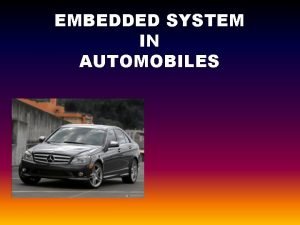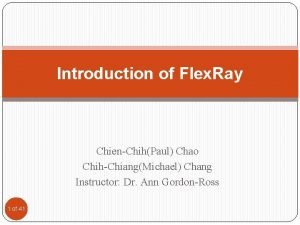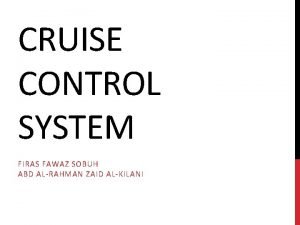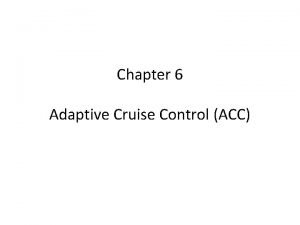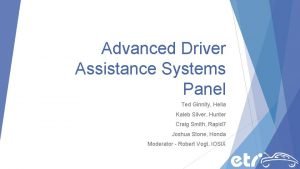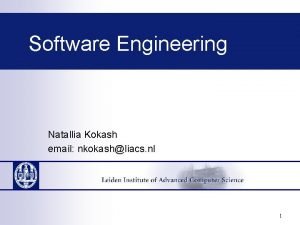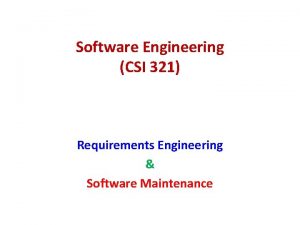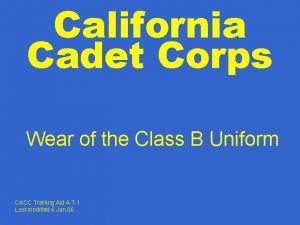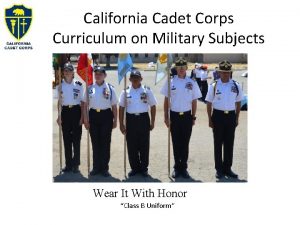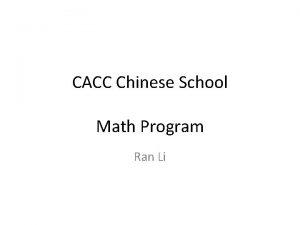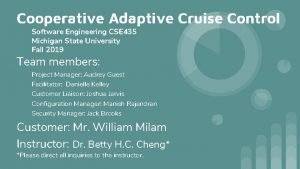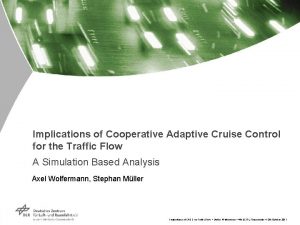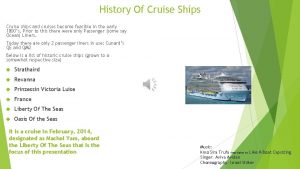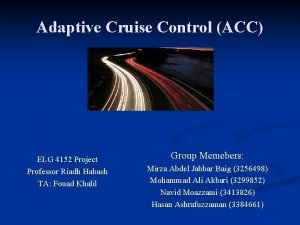Cooperative Adaptive Cruise Control CACC 2 Software Engineering














- Slides: 14

Cooperative Adaptive Cruise Control (CACC 2) Software Engineering CSE 435 Michigan State University Fall 2019 Team members: Project Manager: Brendan Carpio Facilitator: Joseph Stafford Customer Liaison: Colin Heinemann Configuration Manager: Jake De. Nell Security Manager: Yuheng Zhang Customer: Mr. William Milam, Ford Motor Company Instructor: Dr. Betty H. C. Cheng* 1 *Please direct all inquiries to the instructor.

Project Overview • What is CACC? – Advanced cruise control. – Creates groups of vehicles called “platoons”. – Platoons travel at a specified speed with all vehicles in close proximity of each other. • The specified speed is set by the platoon leader (the leading vehicle in the platoon). – All vehicles in the platoon speed up and slow down together. • Motivation for CACC – Maximize safety and efficiency on the roads. – Eventually transition towards partial or total automation of a vehicle, or even groups of vehicles. 2

Overview of Features • Joining and Leaving a Platoon – Joining a Platoon: • If a platoon already exists directly in front within 100 meters of the vehicle: – Our vehicle will automatically join. – Lead vehicles of platoons can merge or join additional platoons. • If a platoon does not exist: – Our vehicle will create a new platoon with itself as the leader. – Leaving a Platoon: • Initiated by indicating to switch lanes or press breaks. • Platoon splits into two. 3

Overview of Features (cont. ) • Obstacle Detection – Forward facing cameras and sensors constantly looking for obstacles in their intended path. – Obstacles will split platoon. • 2 G Maximum breaking limit – If the leading Vehicle determines that an emergency stop is required due to road conditions ahead: • Will max out braking ability without exceeding 2 Gs on driver • Driver can take additional measures 4

Overview of Features (cont. ) • A coding error in the system that causes an unwanted acceleration/deceleration of the vehicle – Vehicle will detect the discrepancy between the commanded value to the throttle controller and the system context based on system inputs and state variables. • Disengages CACC and leaves driver in control. 5

Domain Research • Abandoned centralized system implementation – Requires greater resources. – Complexity of message passing. • Researched current cruise control systems and platooning attempts. • Used previous driving experiences. • Constraints: – Must not exert more than 2 Gs on the driver. – Must always be wirelessly connected. 6

Model-based View of System: Use Case Diagram 7

8

CACC Interface • CACC is just an improved cruise control system – Interface is the same as existing systems: toggle on/off, brake. – Status light shows if system is active. – Turning indicator to manually split from CACC. 9

Sample Scenarios • Creating a platoon: – If CACC is activated and no platoons are within 100 meters then a new platoon will be created with the leader being that vehicle. 10

Sample Scenarios (cont. ) • Joining a platoon – If a platoon already exists directly in front of the vehicle within 100 meters: • CACC will automatically join. 11

Sample Scenarios (cont. ) • Leaving a platoon – Driver presses their brakes. – Driver steers into an adjacent lane. – Turns off CACC 12

Sample Scenarios (cont. ) • Non-CACC vehicle or object cuts off midway in the platoon. – Vehicle directly behind obstacle makes itself head of a new platoon. – Vehicles ahead of the obstacle do not change behavior. 13

Acknowledgements • We gratefully acknowledge and appreciate the participation of our customer, Mr. William Milam from Ford Motor Company. 14
 Adaptive cruise control embedded system
Adaptive cruise control embedded system Adaptive cruise control
Adaptive cruise control Adaptive cruise control
Adaptive cruise control Adaptive cruise control diagram
Adaptive cruise control diagram Adaptive cruise control
Adaptive cruise control Adaptive maintenance in software engineering
Adaptive maintenance in software engineering Software maintenance cost factors
Software maintenance cost factors Adaptive maintenance in software engineering
Adaptive maintenance in software engineering Cruise control continuous integration
Cruise control continuous integration Simulink cruise control
Simulink cruise control Cruise control continuous integration
Cruise control continuous integration The cruise-control function on georgina's car
The cruise-control function on georgina's car Gig line uniform
Gig line uniform California cadet corps ranks
California cadet corps ranks Cacc chinese school
Cacc chinese school
